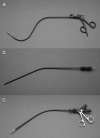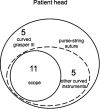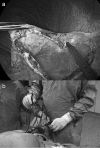Single-access transumbilical laparoscopic unroofing of a giant hepatic cyst using reusable instruments
- PMID: 23477183
- PMCID: PMC3481242
- DOI: 10.4293/108680812x13427982377300
Single-access transumbilical laparoscopic unroofing of a giant hepatic cyst using reusable instruments
Abstract
Introduction: Single-access laparoscopy has garnered growing interest in recent years in an attempt to improve cosmesis, reduce postoperative pain, and minimize abdominal wall trauma.
Case description: A female patient suffering from a symptomatic giant biliary cyst of the liver segments 4-7-8 was admitted for transumbilical single-access laparoscopic cyst unroofing. The procedure was performed using a standard 11-mm reusable trocar for a 10-mm, 30 degree-angled, rigid scope and curved reusable instruments inserted transumbilically without trocars. Operative time was 90 minutes, and the final incision length was 14 mm. The use of minimal pain medication permitted discharge on the third postoperative day, and after 25 months, the patient remains asymptomatic with a no visible umbilical scar.
Conclusions: Giant biliary cysts can be removed by single-access laparoscopy. Because of this technique, surgeons work in ergonomic positions, and the cost of the procedure remains similar to that of the multitrocar technique. The incision length and the use of pain medication are kept minimal as well.
Figures





Similar articles
-
Single-access transumbilical laparoscopic appendectomy and cholecystectomy using new curved reusable instruments: a pilot feasibility study.Surg Endosc. 2011 Apr;25(4):1325-32. doi: 10.1007/s00464-010-1304-7. Epub 2010 Aug 31. Surg Endosc. 2011. PMID: 20809190
-
SINGLE-ACCESS TRANSUMBILICAL LAPAROSCOPIC APPENDECTOMY USING CURVED REUSABLE INSTRUMENTS: AN INITIAL REPORT OF THREE CASES.Khirurgiia (Sofiia). 2015;81(3):135-41. Khirurgiia (Sofiia). 2015. PMID: 26887060 English, Russian.
-
Single-incision laparoscopic surgery versus standard laparoscopic surgery for unroofing of hepatic cysts.JSLS. 2014 Apr-Jun;18(2):246-51. doi: 10.4293/108680813X13753907291512. JSLS. 2014. PMID: 24960488 Free PMC article.
-
Case report: laparoendoscopic single-site fenestration of giant hepatic cyst.Surg Technol Int. 2010 Oct;20:133-6. Surg Technol Int. 2010. PMID: 21082558 Review.
-
Laparoscopic fenestration of giant posterolateral liver cyst.J Laparoendosc Surg. 1995 Aug;5(4):255-7. doi: 10.1089/lps.1995.5.255. J Laparoendosc Surg. 1995. PMID: 7579680 Review.
References
-
- Descottes B, Glineur D, Lachachi F, et al. Laparoscopic liver resection of benign liver tumors. Surg Endosc. 2003;17:23–30 - PubMed
-
- Burpee SE, Kurian M, Murakame Y, Benevides S, Gagner M. The metabolic and immune response to laparoscopic versus open liver resection. Surg Endosc. 2002;16:899–904 - PubMed
-
- Gaujoux S, Kingham TP, Jarnagin WR, D'Angelica MI, Allen PJ, Fong Y. Single-incision laparoscopic liver resection. Surg Endosc. 2011;25:1489–1494 - PubMed
Publication types
MeSH terms
LinkOut - more resources
Full Text Sources
Medical
